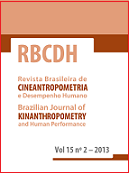Relationship between foot sensibility and postural control in the young and elderly
DOI:
https://doi.org/10.1590/1980-0037.2013v15n2p215Abstract
Impairments in the foot sensitivity in the elderly cause changes in locomotion and postural control that may increase fall risk. Understanding the use of foot afference in the elderly may help preventing loss of mobility and fall. However, there are few studies addressing the relation between the sensitivity of different foot regions and postural control. To investigating this lack in literature, the objective of our study was to assess the relationship between foot sensibility and postural control in young and elderly. Forty-two subjects volunteered to this study; they were assigned to a group according to their age (young or elderly). The participants were assessed regarding anthropometry, foot sensibility (using monofilaments) and postural control (using a force plate). The indexes of foot sensibility and postural control were correlated and compared between the groups. Elderly had worst foot sensibility and postural control than young. Center of pressure are and amplitude in antero-posterior direction were correlated with the general foot sensibility, but not with a specific point of the foot in the elderly. For young, the sensitivity in the forefoot region was related to improved postural control.Downloads
Published
2013-03-01
Issue
Section
Original Articles



